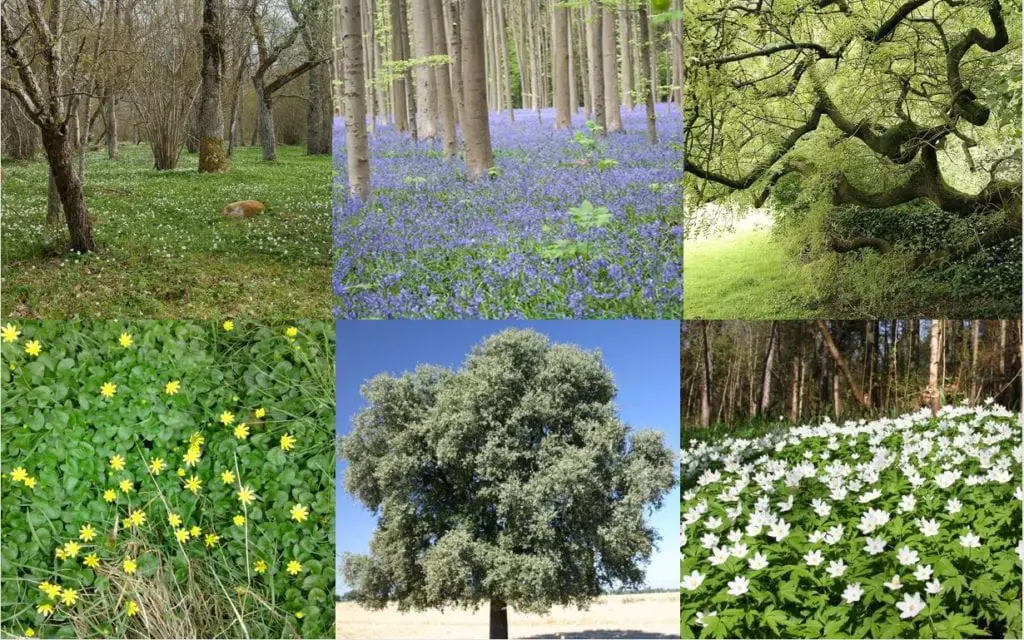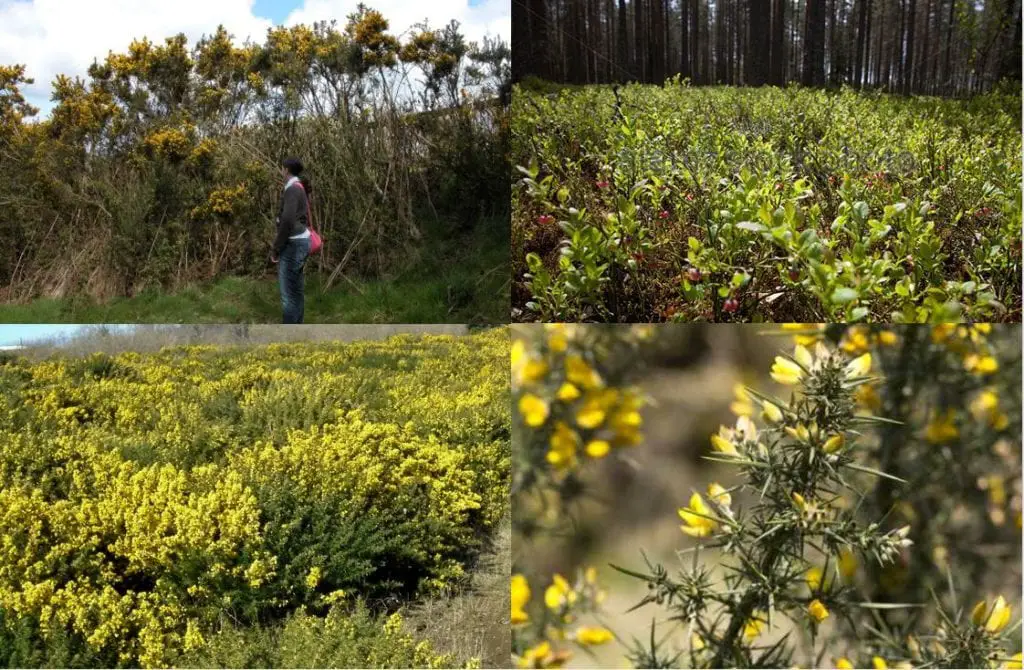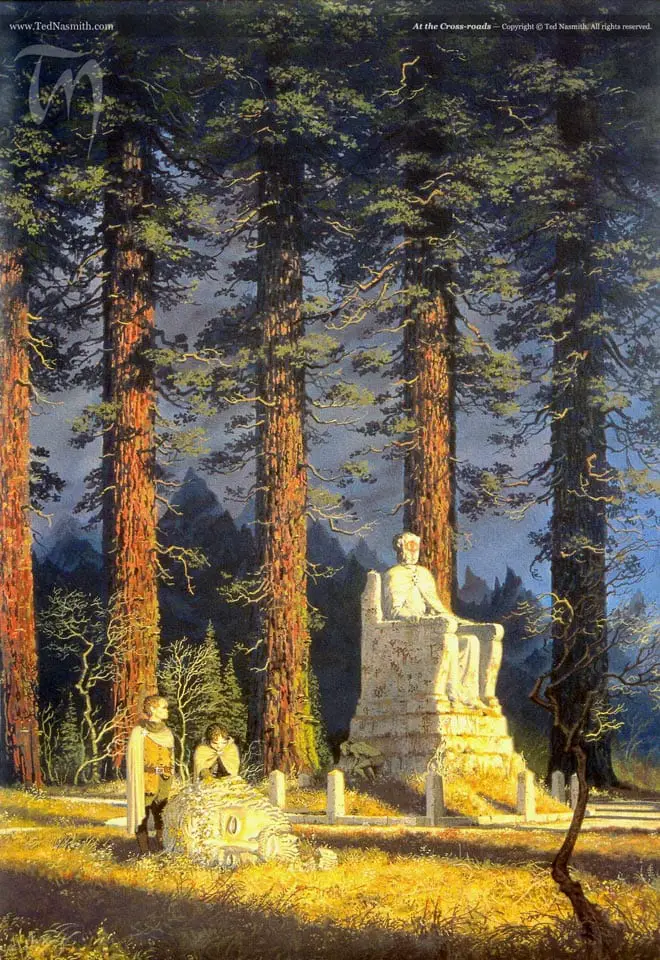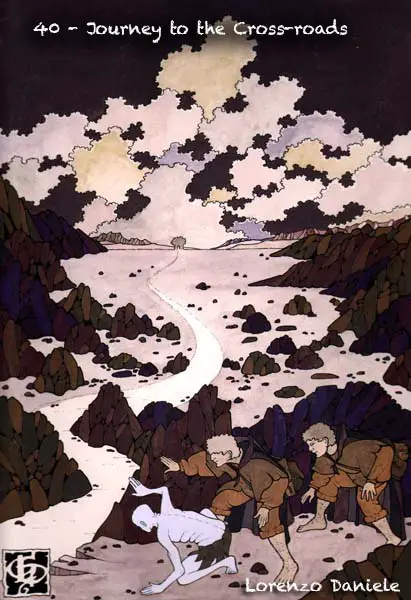More than any other chapter so far, I went into “Journey to the Crossroads” remembering very little of what happened. After reading it, I understand why: not much does happen.
That’s not a bad thing. It’s a slow chapter, designed to build the mood and reset the scene. After the calm, cool chatting by a waterfall of “The Window on the West,” Frodo and Sam are thrust back into the silent, unstable reality of their quest.
Tolkien has fun with his landscapes, as he always does. He establishes a very traditional calm-before-the-storm atmosphere throughout, starting with Faramir’s observation that, strangely, the land is empty. “A waiting silence broods above the Nameless Land. I do not know what that portends. But the time draws swiftly to some great conclusion.” Birds are silent, animals have gone. Dark shadows well up in the east. “The air grew heavy, and it began to be stifling under the trees. It felt as if thunder were brewing.” It’s not terribly subtle stuff.
But Tolkien makes it his own by shifting the chapter from a calm-before-the-storm narrative to something more akin to a calm-away-from the storm. Frodo and Sam are about to head into a storm of their own. But this chapter is much more concerned with the odd status of their position in the narrative writ-large. As they move from one location to another (physically and symbolically), battles and grand deeds are rolling out around them. And they’re powerless to do anything but listen. They are the central, most important part of the quest, but one that is by nature is shunted off to the side, keeping silent as thunder spills across the plains. It’s a nice reminder of how non-traditional Frodo and Sam can be as protagonists.
At Home Among Trees
Tolkien has a long-standing tendency to imbue landscapes with moral and symbolic import, whether the shifting landscape around the Great River or the obvious transition as Aragorn, Legolas, and Gimli run from Emyn Muil into the land of Rohan. It’s a trend that he continues here, but in microcosm. Each stage of the hobbits’ (and Gollum’s) journey corresponds to a different sort of landscape (or tree), as they move away from Henneth Annun and into the final stage of their journey.
Frodo and Sam first come into contact with the wood from the lebethron tree, via that staves that Faramir gave to them. It not only gives them a more permanent, tangible tie to Faramir and his friendship, but it also serves as a nice parallel to the Fellowship’s departure from Lórien in The Fellowship of the Ring. As they move away from the waterfall and into the woods of Ithilien, they fall back into a similar landscape to that in “Of Herbs and Stewed Rabbit.”

Great ilexes of huge girth stood dark and solemn in wide glades with here and there among them hoary ash-trees, and giant oaks just putting out their brown-green buds. About them lay long launds of green grass dappled with celandine and anemones, white and blue, now folded for sleep; there were acres populous with the leave of woodland hyancinths: already their sleek bell-stems were thrusting through the mould.
It’s a peaceful setting – a canopy of solemn, strong trees, bursts of bright flowers, hints of spring. The landscape even acts as direct shelter for the hobbits, when they climb the branches of a tree to seek shelter for the night (another Lórien parallel). The hobbits still very much feel as if they are in a relatively safe space, despite the ominously growing absence of sound.
Leaving the shelter of the forest around Henneth Annun leads to a sudden, rather drastic change in the landscape. Rather than large trees and blankets of flowers, the landscape turns dry and ragged.

Soon they began to climb up on to a great hog-back of land. For the most part it was covered with a thick growth of gorse and whortleberry, and low tough thorns, though here and there clearings opened, the scars of recent fires. The gorse-bushes became more frequent as they got nearer the top; very old and tall they were, gaunt and leggy below but thick above… So tall were the spiny thickets that the hobbits could walk upright under them, passing through long dry aisles carpeted with a deep prickly mould.
The shift from solid, solemn trees to spindly, top-heavy brush is a nice parallel to the darkness that’s spreading out over the land. No dawn: just “dead brown twilight.” And top-heavy gorse bushes (covered in the pointy thorns you can see above) lay down the subtle implication that it’s only a matter of time before something comes crashing down. It’s a precarious, brittle landscape that underlines the fragility of Frodo and Sam’s position as darkness stretches over the land.
Character and Landscape
Even beyond the trees, it’s interesting to see how Tolkien uses landscape to integrate his characters into the narrative. A lot of time is spent in “Journey to the Crossroads” implying how far Sam and Frodo are from the swirl of action surrounding them. Frodo is continually positioned as looking off towards Mordor, looking off towards Gondor, observing the “fire-flecked sky” above the White City or the “great blackness looming slowly out of the East, eating up the faint blurred stars.” Thunder is distant and constant. But the hobbits never really understand what is happening or what precisely is causing the noise. They simply have to keep going.
This distance from the action – but also continuing danger – makes Frodo and Sam’s position feel powerless in an amplified way. Throughout Book IV Frodo and Sam have felt small, plucky underdogs pitted against an array of impossible power. But in “Journey to the Crossroads” they feel unmoored, like small pieces about to be swept away by the waves crashing in the distance. This is only exacerbated by the continual tensions and contrasts at play throughout the chapter, even beyond the landscape. There is almost literally nothing happening around Frodo and Sam. Yet Gollum is suddenly whipped up into a panic: “Time’s running short, yes, running fast. No time to lose. We must go.” The tension between silence and haste is unnerving.

The most powerful example, though, comes right at the chapter’s end. It’s a relatively well-known and optimistic moment: a beam of light shines through the darkness onto an old stone statue’s head. It’s hopeful: as Frodo says, “They cannot conquer forever.” But in context, it’s an unsettling and ambiguous moment.
Turning towards it, he saw, beyond an arch of boughs, the road to Osgiliath running almost as straight as a stretched ribbon down, down into the West. There, far away, beyond sad Gondor now overwhelmed in shade, the Sun was sinking, finding at last the hem of the great slow-rolling pall of cloud, and falling in an ominous fire towards the yet unsullied Sea. The brief glow fell upon a huge sitting figure, still and solemn as the great stone kings of Argonath. The years had gnawed at it, and violent hands had maimed it. Its head was gone, and in its place was set in mockery a round, rough-hewn stone, rudely painted by savage hands in the likeness of a grinning face with one large red eye in the midst of its forehead.
Already, the tone is bouncing back and forth. At first, there seems to be a glimmer of hope. Frodo sees a beam of light on a day filled with darkness. And it lands upon a figure “still and solemn as the great stone kings of Argonath.” But at the same time, the beam of light is coming from the sun – an “ominous fire” that is falling towards the Sea, which is only “not yet” unsullied. And the statue itself is degraded and defaced, something beautiful turned into a mockery marked by the Eye of Sauron.
But things seem to take a turn again, as Frodo sees the statue’s real head lying nearby:
“Look, Sam!” he cried, startled into speech. “Look! The king has got a crown again.”
The eyes were hollow and the carven beard was broken, but about the high stern forehead there was a coronal of silver and gold. A trailing plant with flowers like small white stars had bound itself across the brows as if in reverence for the fallen king, and in the crevices of his stone hair yellow stonecrop gleamed. “They cannot conquer forever!” said Frodo.
It’s a classic Tolkien move, a symbol of hope and light in the face of fear and darkness. It’s honestly where I remember the chapter coming to an end. But there are two more sentences.
And then suddenly the glimpse was gone. The Sun dipped and vanished, and as if at the shuttering of a lamp, black night fell.
It’s a blunt, unsettling end to the chapter. Just as something beautiful and hopeful happens it’s suddenly snuffed out and the scene ends plunged into darkness. The whole passage with the statue is fascinating, and odd mixture of hope and fear mingled together into uncertainty, as thunder rolls persistently in the distance.

Final Comments
- Speaking of trees, it’s intriguing how the line of trees around the crossroads itself seem to be an odd inversion / combination of the last two landscapes: As they drew nearer they became aware that [the trees] were of vast size, very ancient it seemed, and still towering high, though their tops were gaunt and broken, as if tempest and lightning blast had swept across them, but had failed to kill them or to shake their fathomless roots. There are the vast ancient trees, but they have their tops cut off rather than being top heavy. Not sure it really means anything, but it was interesting. And it adds to the precariousness of the landscape and general mood.
- Does mould have different connotations in British English? Frodo keeps sleeping on mould, a concept it very upsetting to me despite more pressing matters on the horizon. From context I’m thinking that it might be the leaves & detritus that collect on the forest floor?
- I really like Sam’s dream. He’s looking for his pipe and wakes up unable to find it, then realizes in rapid stages that while his pipe might be in his pack, he has no pipeweed and is vast distances from home. It feels like such a realistic detail. It wouldn’t surprise me to hear that Tolkien himself had a similar dream during his time away at war.
- Prose Prize: “There is seemed to Frodo that he descried far off, floating as it were on a shadowy sea, the high dim tops and broken pinnacles of old towers forlorn and dark.” There were lots of good candidates this chapter. It’s a chapter dedicated predominately to mood setting, which means lots of pretty prose (I was also partial to the “fire-flecked sky” above Gondor). But it’s been a while since Tolkien gave some Caspar-David-Friedrich-style references to the old and abandoned ruins of Middle-earth. I always have a soft spot for it, poking around on the mythological edges of the story.
- Tolkien’s Wanton Cruelty to Innocent Punctuation Marks (sponsored by Mytly): Not all that cruel, but a fun Tolkien grammar fact! When talking about plants, it appears to be nearly impossible for Tolkien not to start stacking colons and semicolons. This one’s not bad (only two!) but of course it’s about plants. I get it though. Plant names are often beautiful on the level of linguistic aesthetics. And Tolkien dives right in, listing them all off so the names and sounds can bounce off each other at will. “About them lay long launds of green grass dappled with celandine and anemones, white and blue, now folded for sleep; there were acres populous with the leave of woodland hyancinths: already their sleek bell-stems were thrusting through the mould.” Not cruel, good job Tolkien.
- Contemporary to this Chapter: A lot of things are falling into place as Frodo, Sam, and Gollum make their way towards Mordor. Gandalf and Pippin have finally arrived at Minas Tirith. Théoden reaches Dunharrow where he meets up with Éowyn; Aragorn prepares to march from Erech with the Army of the Dead. As the darkness spreads from Mordor, Gandalf rescues Faramir outside the gates of Minas Tirith. The final battles in the War of the Ring are taking shape.
- I am delighted tha this re-read is gonna fit perfectly into the calendar year, barring any seasonal delays. Truly nothing says the winter holidays like spider monsters and a good shot of friend separation and despair.
- So, uh, yeah! There’s news. Potential news. Maybe news? Please tell me your feelings. I’m currently setting up my tent in Camp Expect-the-Worst-but-Hope-for-the-Best. It seems needless, to me, and I’m not convinced that Amazon has any desire to make an interesting, insightful adaptation. It’s easy to see it as an easy cash-in on a marketable property. That said, I’m neutral until more news comes out. Who they get to run this will probably say a lot. In any case, deep-seated loyalties will almost certainly make me resent most of the future cast. Sorry!
Art Credits (in order of appearance): Miruna Lavinia, Ted Nasmith, Lorenzo Daniele.

